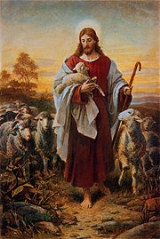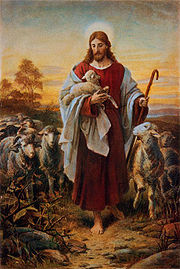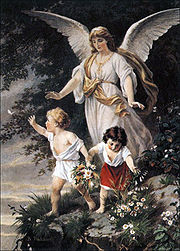
Bernhard Plockhorst
Encyclopedia
Bernhard Plockhorst was a German painter and graphic artist. In Germany, Plockhorst is only known to experts today, whereas his pictures are still very popular in the United States and their reproductions can be found in many American homes and churches.

 Plockhorst was born in Brunswick
Plockhorst was born in Brunswick
, Germany, where he took a five years’ education in lithography at the Collegium Carolinum. Then he trained to be a painter with Julius Schnorr von Carolsfeld
in Dresden
in 1848, with Carl von Piloty in Leipzig
and Munich
and finally with Thomas Couture
in Paris
in 1853. In Munich, Plockhorst copied the pictures of Rubens
and Tizian in the Old Pinakothek
. He also took study travels to Belgium, the Netherlands and Italy. Then he settled in Berlin
where he began to paint portraits, but he also proved his talent for religious themes with a large painting (“Mary and John returning from the grave of Christ”). From 1866 to 1869, he was a professor at the Grandducal Saxonian Art School (Großherzoglich-Sächsische Kunstschule) in Weimar
, where the painter Otto Piltz was one of his pupils. Then Plockhorst returned to Berlin where he died in 1907.
, a German Romantic art school (together with other German Protestant painters such as Karl Gottfried Pfannschmidt and Heinrich Hoffmann). Influenced by the Pre-Raphaelite Brotherhood
, they had recourse to Medieval and religious art topics.
). His next major work was the altar painting “The Resurrection of Christ” for the cathedral of Marienburg
, painted by order of the Prussian ministry of education and cultural affairs.
Further paintings showed “Christ taking his leave of his Mother”, “Christ on his way to Emmaus”, “Christ appearing to Maria Magdalena”, “The exposure of Moses”, “The finding of Moses”, “Let the children come to me” (also called “Jesus blessing the children”), “Luther
on Christmas Eve” (1887) and “The adulteress before Christ” (the latter formerly in Moscow
, gallery Löwenstein).
Plockhorst’s painting The Guardian Angel (1886), showing an angel and two little children close to an abyss, was reproduced as a color lithography in thousands of copies and greatly influenced the later pictures of guardian angels.
The glass windows of several U.S. American churches show motifs taken from Plockhorst, e. g. “The Nativity
” in the Emmanuel Episcopal Church in Shawnee
, Oklahoma; "The Good Shepherd" in First Presbyterian Church in Tulsa, Oklahoma; “Moses presents the Ten Commandments to Aaron
on the mount Sinai
” in the First Congregational Church UCC, Owosso
, Michigan; “The Good Shepherd” in the Zion Lutheran Church, Baltimore
, MD, and “The Flight into Egypt” in the Stanford Memorial Church
.
Plockhorst’s oil painting “Noli me tangere
”, which is more than two square meters large, had a remarkable fate. Originally, Plockhorst painted it for the German Supreme Court. Later, it should be sold to England, but the ship “Sorata” sank with the painting on board. The work of art could be rescued, but it was completely encrusted by a white layer. It looked as if the sea water had decomposed the color particles. In this condition, a German commissioner, professor Rouleaux, took it to Melbourne, Australia. When the Melbourne International Exhibition
was prepared in 1880, the art dealer Alexander Fletcher (1837–1914) bought the painting for a trifling sum and took it to the restorer Peacock. Peacock discovered that the white layer only consisted of plaster from the frame which had dissolved by the sea water. He could easily remove it and Fletcher sold the restored painting to the National Gallery of Victoria
for a considerable sum. At that time, the three largest daily newspapers of Melbourne reported extensively on that clever move.
(1857) and created portraits of other important people like the Leipzig publisher Tauchnitz, the Leipzig honorary citizen Carl Lampe, David Hansemann
and the children of the family Platzmann. Besides, he portrayed members of the German nobility like Emperor Wilhelm I and his wife Augusta
(1888; today in Berlin, National Gallery).
His illustrations for the following two books became very successful,
Life


Braunschweig
Braunschweig , is a city of 247,400 people, located in the federal-state of Lower Saxony, Germany. It is located north of the Harz mountains at the farthest navigable point of the Oker river, which connects to the North Sea via the rivers Aller and Weser....
, Germany, where he took a five years’ education in lithography at the Collegium Carolinum. Then he trained to be a painter with Julius Schnorr von Carolsfeld
Julius Schnorr von Carolsfeld
Julius Schnorr von Carolsfeld was a German painter.-Biography:Schnorr was born at Leipzig, where he received his earliest instruction from his father Johann Veit Schnorr , a draughtsman, engraver and painter...
in Dresden
Dresden
Dresden is the capital city of the Free State of Saxony in Germany. It is situated in a valley on the River Elbe, near the Czech border. The Dresden conurbation is part of the Saxon Triangle metropolitan area....
in 1848, with Carl von Piloty in Leipzig
Leipzig
Leipzig Leipzig has always been a trade city, situated during the time of the Holy Roman Empire at the intersection of the Via Regia and Via Imperii, two important trade routes. At one time, Leipzig was one of the major European centres of learning and culture in fields such as music and publishing...
and Munich
Munich
Munich The city's motto is "" . Before 2006, it was "Weltstadt mit Herz" . Its native name, , is derived from the Old High German Munichen, meaning "by the monks' place". The city's name derives from the monks of the Benedictine order who founded the city; hence the monk depicted on the city's coat...
and finally with Thomas Couture
Thomas Couture
Thomas Couture was an influential French history painter and teacher. Couture taught such later luminaries of the art world as Édouard Manet, Henri Fantin-Latour, John La Farge, Pierre Puvis de Chavannes, Karel Javůrek, and J-N Sylvestre.-Life:He was born at Senlis, Oise, France...
in Paris
Paris
Paris is the capital and largest city in France, situated on the river Seine, in northern France, at the heart of the Île-de-France region...
in 1853. In Munich, Plockhorst copied the pictures of Rubens
Rubens
Rubens is often used to refer to Peter Paul Rubens , the Flemish artist.Rubens may also refer to:- People :Family name* Paul Rubens Rubens is often used to refer to Peter Paul Rubens (1577-1640), the Flemish artist.Rubens may also refer to:- People :Family name* Paul Rubens (composer) Rubens is...
and Tizian in the Old Pinakothek
Alte Pinakothek
The Alte Pinakothek is an art museum situated in the Kunstareal in Munich, Germany. It is one of the oldest galleries in the world and houses one of the most famous collections of Old Master paintings...
. He also took study travels to Belgium, the Netherlands and Italy. Then he settled in Berlin
Berlin
Berlin is the capital city of Germany and is one of the 16 states of Germany. With a population of 3.45 million people, Berlin is Germany's largest city. It is the second most populous city proper and the seventh most populous urban area in the European Union...
where he began to paint portraits, but he also proved his talent for religious themes with a large painting (“Mary and John returning from the grave of Christ”). From 1866 to 1869, he was a professor at the Grandducal Saxonian Art School (Großherzoglich-Sächsische Kunstschule) in Weimar
Weimar
Weimar is a city in Germany famous for its cultural heritage. It is located in the federal state of Thuringia , north of the Thüringer Wald, east of Erfurt, and southwest of Halle and Leipzig. Its current population is approximately 65,000. The oldest record of the city dates from the year 899...
, where the painter Otto Piltz was one of his pupils. Then Plockhorst returned to Berlin where he died in 1907.
Work
Plockhorst was a member of the late Nazarene movementNazarene movement
The name Nazarene was adopted by a group of early 19th century German Romantic painters who aimed to revive honesty and spirituality in Christian art...
, a German Romantic art school (together with other German Protestant painters such as Karl Gottfried Pfannschmidt and Heinrich Hoffmann). Influenced by the Pre-Raphaelite Brotherhood
Pre-Raphaelite Brotherhood
The Pre-Raphaelite Brotherhood was a group of English painters, poets, and critics, founded in 1848 by William Holman Hunt, John Everett Millais and Dante Gabriel Rossetti...
, they had recourse to Medieval and religious art topics.
Religious topics
In 1872, Plockhorst exhibited a painting which was soon regarded as his chief work, “The Battle of archangel Michael with Satan for the body of Moses” (today in the Städtisches Museum, CologneCologne
Cologne is Germany's fourth-largest city , and is the largest city both in the Germany Federal State of North Rhine-Westphalia and within the Rhine-Ruhr Metropolitan Area, one of the major European metropolitan areas with more than ten million inhabitants.Cologne is located on both sides of the...
). His next major work was the altar painting “The Resurrection of Christ” for the cathedral of Marienburg
Kwidzyn
Kwidzyn is a town in northern Poland on the Liwa river, with 40,008 inhabitants . It has been a part of the Pomeranian Voivodeship since 1999, and was previously in the Elbląg Voivodeship . It is the capital of Kwidzyn County.-History:...
, painted by order of the Prussian ministry of education and cultural affairs.
Further paintings showed “Christ taking his leave of his Mother”, “Christ on his way to Emmaus”, “Christ appearing to Maria Magdalena”, “The exposure of Moses”, “The finding of Moses”, “Let the children come to me” (also called “Jesus blessing the children”), “Luther
Martin Luther
Martin Luther was a German priest, professor of theology and iconic figure of the Protestant Reformation. He strongly disputed the claim that freedom from God's punishment for sin could be purchased with money. He confronted indulgence salesman Johann Tetzel with his Ninety-Five Theses in 1517...
on Christmas Eve” (1887) and “The adulteress before Christ” (the latter formerly in Moscow
Moscow
Moscow is the capital, the most populous city, and the most populous federal subject of Russia. The city is a major political, economic, cultural, scientific, religious, financial, educational, and transportation centre of Russia and the continent...
, gallery Löwenstein).
Plockhorst’s painting The Guardian Angel (1886), showing an angel and two little children close to an abyss, was reproduced as a color lithography in thousands of copies and greatly influenced the later pictures of guardian angels.
The glass windows of several U.S. American churches show motifs taken from Plockhorst, e. g. “The Nativity
Nativity of Jesus in art
The Nativity of Jesus has been a major subject of Christian art since the 4th century. The artistic depictions of the Nativity or birth of Jesus, celebrated at Christmas, are based on the narratives in the Bible, in the Gospels of Matthew and Luke, and further elaborated by written, oral and...
” in the Emmanuel Episcopal Church in Shawnee
Shawnee
The Shawnee, Shaawanwaki, Shaawanooki and Shaawanowi lenaweeki, are an Algonquian-speaking people native to North America. Historically they inhabited the areas of Ohio, Virginia, West Virginia, Western Maryland, Kentucky, Indiana, and Pennsylvania...
, Oklahoma; "The Good Shepherd" in First Presbyterian Church in Tulsa, Oklahoma; “Moses presents the Ten Commandments to Aaron
Aaron
In the Hebrew Bible and the Qur'an, Aaron : Ααρών ), who is often called "'Aaron the Priest"' and once Aaron the Levite , was the older brother of Moses, and a prophet of God. He represented the priestly functions of his tribe, becoming the first High Priest of the Israelites...
on the mount Sinai
Mount Sinai
Mount Sinai , also known as Mount Horeb, Mount Musa, Gabal Musa , Jabal Musa meaning "Moses' Mountain", is a mountain near Saint Catherine in the Sinai Peninsula of Egypt. A mountain called Mount Sinai is mentioned many times in the Book of Exodus in the Torah and the Bible as well as the Quran...
” in the First Congregational Church UCC, Owosso
Owosso, Michigan
Owosso is a city in Shiawassee County in the U.S. state of Michigan. The population was 15,713 at the 2000 census. The city is located on the eastern side of Owosso Township, but is politically independent...
, Michigan; “The Good Shepherd” in the Zion Lutheran Church, Baltimore
Baltimore
Baltimore is the largest independent city in the United States and the largest city and cultural center of the US state of Maryland. The city is located in central Maryland along the tidal portion of the Patapsco River, an arm of the Chesapeake Bay. Baltimore is sometimes referred to as Baltimore...
, MD, and “The Flight into Egypt” in the Stanford Memorial Church
Stanford Memorial Church
Stanford Memorial Church is located at the center of the Stanford University campus in Stanford, California, United States. It was built during the American Renaissance by Jane Stanford as a memorial to her husband Leland. Designed by architect Charles A...
.
Plockhorst’s oil painting “Noli me tangere
Noli me tangere
Noli me tangere, meaning "don't touch me" / "touch me not", is the Latin version of words spoken, according to , by Jesus to Mary Magdalene when she recognizes him after his resurrection....
”, which is more than two square meters large, had a remarkable fate. Originally, Plockhorst painted it for the German Supreme Court. Later, it should be sold to England, but the ship “Sorata” sank with the painting on board. The work of art could be rescued, but it was completely encrusted by a white layer. It looked as if the sea water had decomposed the color particles. In this condition, a German commissioner, professor Rouleaux, took it to Melbourne, Australia. When the Melbourne International Exhibition
Melbourne International Exhibition (1880)
The Melbourne International Exhibition was held from 1 October 1880 until 30 April 1881. It was the second international exhibition to be held in Australia , the first being held the previous year in Sydney...
was prepared in 1880, the art dealer Alexander Fletcher (1837–1914) bought the painting for a trifling sum and took it to the restorer Peacock. Peacock discovered that the white layer only consisted of plaster from the frame which had dissolved by the sea water. He could easily remove it and Fletcher sold the restored painting to the National Gallery of Victoria
National Gallery of Victoria
The National Gallery of Victoria is an art gallery and museum in Melbourne, Australia. Founded in 1861, it is the oldest and the largest public art gallery in Australia. Since December 2003, NGV has operated across two sites...
for a considerable sum. At that time, the three largest daily newspapers of Melbourne reported extensively on that clever move.
Portraits
Plockhorst painted a portrait of the musician Franz LisztFranz Liszt
Franz Liszt ; ), was a 19th-century Hungarian composer, pianist, conductor, and teacher.Liszt became renowned in Europe during the nineteenth century for his virtuosic skill as a pianist. He was said by his contemporaries to have been the most technically advanced pianist of his age...
(1857) and created portraits of other important people like the Leipzig publisher Tauchnitz, the Leipzig honorary citizen Carl Lampe, David Hansemann
David Hansemann
David Justus Ludwig Hansemann was a Prussian politician and banker, serving as the Prussian Minister of Finance in 1848.- Life :...
and the children of the family Platzmann. Besides, he portrayed members of the German nobility like Emperor Wilhelm I and his wife Augusta
Augusta of Saxe-Weimar
Augusta of Saxe-Weimar-Eisenach was the Queen of Prussia and the first German Empress as the consort of William I, German Emperor.-Early life:...
(1888; today in Berlin, National Gallery).
Illustrations
For the books of the Tauchnitz publishing house, Plockhorst drew different title-pages and frontispieces, e.g. for “Three tales for Girls” by the British author Dinah Maria Mulock Craik and for Charlotte M. Yonge’s book “The little Duke or Richard the Fearless. Ben Sylvester’s Word“ (1861).His illustrations for the following two books became very successful,
- “From Bethlehem to Golgatha. The Life of our Lord and Savior Jesus Christ according to the four gospels” by Karl Gerok (1881);
- “Psalter and harp. New jubilee edition” by Philipp Spitta, including 24 full-page illustrations, the portrait of Spitta, further illustrations and 42 initials.
Written sources
- Article on Bernhard Plockhorst, in: Brockhaus Konversations-Lexikon, vol. 13 (1895), p. 203.

